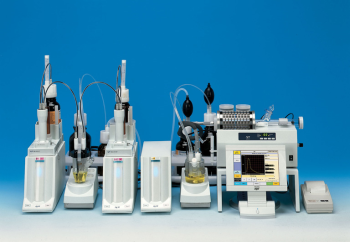 Most people know about Karl Fisher as a method for determining moisture content. After that there seems to be confusion when the words “Coulometric” and “Volumetric” are mentioned. It goes something like this:
Most people know about Karl Fisher as a method for determining moisture content. After that there seems to be confusion when the words “Coulometric” and “Volumetric” are mentioned. It goes something like this:
Novice: “Hi, I need to test for moisture and I need a Karl Fisher Titrator. Can you tell me how much it costs?”
Expert: “O.K., do you need a Coulometric or Volumetric Karl Fisher Titrator?”
Novice: “uh what?”
Expert: “Well you see there are two kinds of Karl Fisher Titrators. Depending on your sample size and the amount of moisture you expect to find -it may not only be advantageous but necessary to use a Coulometric vs. a Volumetric..and or vice versa.”
Novice: “I see.” So how do I know what kind of Karl Fisher I need?
Expert: “Generally speaking, if you are working with small samples (0 to a few grams) AND the expected moisture is low (around 1% or less) you probably want to use a Coulometric Karl Fisher. On the other hand, if your sample size is larger AND you expect to find a lot of moisture in the 2%+ range then you probably should consider a Volumetric Karl Fisher Titrator.”
Novice: “Do they both report moisture results the same way? You know, accuracy, resolution, repeatability?”
Expert: “Yes they do. Both Volumetric and Coulometric Karl Fisher Titrators report moisture results in either Parts Per Million (PPM) or %.
Novice: “So then what makes them different?”
Expert: “Coulomeric Karl Fisher Titrators use a reagent called an Anolyte. This Anolyte is 100% self contained and requires only an electrical current to cause a reaction where the Anolyte releases iodine. It is this “iodine” that “neutralizes” the moisture inside the vessel. A typical Coulometric Karl Fisher Titration Vessel can hold about 75mL of Anolyte. The amount of Anolyte inside the vessel can only “release” so much iodine and therefore can only neutralize and measure a finite amount of moisture. In this case using the 75mL as the example the reagent can only neutralize and measure 750,000 micro grams of moisture (water/H2O). Now compare this to a Volumetric Karl Fisher and the game changes. The Volumetric Karl Fisher method does not use a single self-contained Anolyte reagent that reacts to an electrical current. Instead, the Volumetric titration is performed by “dripping” in IODINE at an precise amount into the titration vessel where there is a SOLVENT solution present in the vessel.
Novice: “How does the Volumetric Titrator “Drip in” IODINE into the vessel where the SOLVENT is located?”
Expert:”Good question. It uses a buret that has a piston that moves up and down pulling The IODINE solution from a source bottle into and filling the buret and then pushing it out through tubing and into the vessel. ”
Novice: “Is there another name for this “IODINE solution”? How do I get it?
Expert: “Another good question. “This IODINE solution” is what makes the volumetric method so versatile when measuring larger amounts of moisture via Karl Fisher Titration. The Iodine solution can come in two forms and with differing strengths.”
Novice:” Two forms? Different strengths? Huh?
Expert: ” Yes, the two forms are referred to as “One-Component” and “Two-Component”.”
Expert: “The “One-Component” Iodine solution is referred to as Composite or Titer. The Composite can come in 3 strengths; 1 (1mL of composition can consume 1mg or 1,000micro grams of water), 2 (1mL of composition can consume 2mg or 2,000micro grams of water) and 5 (1mL of composition can consume 5mg or 5,000micro grams of water). We refer to these compositions as Composition-1 (aka Comp1), Composition-2 (aka Comp2), and Composition-5 (aka Comp5).
Novice: Differing Strengths. Hmmm. So for every 1mL you “drip in” it will consume, neutralize and measure the corresponding amount of moisture depending on the Composition strength.
Expert: “That’s right. So for example if you use a Volumetric Karl Fisher Titrator with a 20mL buret you could conceivably introduce in one push of the piston that’s inside the buret, 20mLs of Composition. If your using Comp5 you would be able to consume, neutralize and measure 20mL x 5,000 micro grams =100,000 micro grams of water. Most Composition are sold in 500mL bottles. So each bottle has the capacity to consume, neutralize and measure 2,500,000 micro grams of water.
Novice: “That’s a lot of water measuring capability!”
Expert: “Yes it is.”
This is a simple example and there are other factors to be considered for sure. We thought this brief example would help those just getting started and trying to understand the basic comparison between Coulometic Karl Fisher and Volumetric Karl Fisher.




